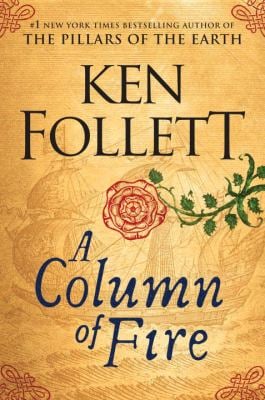I just finished reading Ken Follett’s mammoth historical novel, A Column of Fire.
The novel opens in 1558, just as the reign of the Catholic Queen Mary is coming to an end. Mary has reversed England’s Protestant shift, which began when her father, Henry VIII, decided that he couldn’t make due with one wife and a mistress.
Mary, who is also known to history as “Bloody Mary”, occasionally burned Protestant dissenters, and this is depicted in one of the opening chapters of A Column of Fire. Hence the name of the book.
This is the opening historical backdrop. The hero of the novel is Ned Willard, who is a young man in love as the story opens. The object of Ned’s affections is Margery Fitzgerald. Ned’s affections are returned, but—of course—there is a problem.
Margery hails from a devoutly Catholic family that has prospered under the reign of Mary. Through the connivances of Margery’s fanatically papist brother, Ned loses Margery to Bart, a member of the local Catholic nobility.
And so Margery enters into a loveless marriage with Bart (who is an uncouth, insensitive, and blundering brute), while Ned goes off, forlorn, to seek his fortune in London.
Ned is a lukewarm Protestant who abhors the intolerance of Mary’s reign. Ned longs for a monarch who will allow the British people to worship freely (or as freely as possible, according to 16th-century standards of “freedom”.)
Just as Ned is reeling from the loss of Margery, Mary dies. Elizabeth takes the throne. A chance connection to Sir Francis Walsingham (principal secretary to Elizabeth) enables Ned to enter the service of the Crown. Ned is greatly impressed with the young queen. With the option of a married life with Margery closed off, Ned devotes himself to the service of Queen Elizabeth I, and the implementation of her (initially) tolerant ideals.
There is a lot more to A Column of Fire, of course. This is a 900-page book, after all. There is also a storyline set in France, where Protestants are a minority in an officially Catholic country. Still another set of characters has adventures in Spain and the New World. (All of the storylines converge before the end of the book.)
The overarching theme of A Column of Fire is the religious strife that gripped Europe in the aftermath of the Protestant Reformation. As noted above, the story opens with anti-Protestant burnings in England. Follett later weaves into his plot the St. Bartholomew’s Day Massacre in Paris, and the Gunpowder Plot of 1605. The book covers around half a century. (Ned Willard is in his eighties in the final chapter.)
I loved this book. I have read almost everything that Ken Follett has written to this point, and A Column of Fire is hands-down my favorite.
I like stories with complex twists and turns, and physical threats; and A Column of Fire has all that in spades. There are sea battles, and opposing rings of Catholic and Protestant spies.
The majority of readers seem to agree with me. A Column of Fire is highly rated both on Amazon and Goodreads.
But even a really good book has its flaws. Most of the criticisms of A Column of Fire come from one of two angles, which I’ll address briefly.
Ken Follett seems to harbor a secret desire to be an author of Harlequin romance novels. Almost every movie, novel, and television series has a love interest (or multiple love interests), and I’m not suggesting that this, in itself, is in any way a drawback.
Follett, however, tends to go overboard on his sex scenes.
Now, before you ask, I’m no prude. I’m a fifty-year-old, very heterosexual man with right-leaning libertarian tendencies. I have an equal loathing for leftwing political correctness, and anything that smacks of goody-two-shoes censorship.
That said, there is only so much detail that I need when an author describes a romantic coupling. To be blunt about it: Once the author has described the male protagonist’s erect penis, or the heroine’s moist nether regions, the author has given me more detail than I actually need.
Follett does this on multiple occasions (and in more than a few of his novels). There are some lacunae that an author should trust readers to fill in for themselves.
Secondly, A Column of Fire has something of an anti-Catholic bias. Almost every Catholic character is portrayed as a bloodthirsty fanatic, an amoral schemer, or a deluded simpleton.
(This may be a thing with baby boomer British authors who write historical fiction, as I’ve noticed a similar tendency in the historical novels of Bernard Cornwell.)
These flaws, however, are minor ones. On balance, A Column of Fire is a great read.
A final word before I end: You’ll appreciate A Column of Fire far more if you already have a basic knowledge of European history in general, and the Protestant Reformation in particular. But then, if you don’t already have some interest in history, then it’s unlikely that you’ll be strongly attracted to this book.

